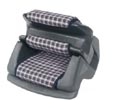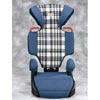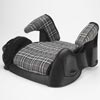 |
 |
 |
|
|
The Dangers
of Shield Boosters Expert Statements on
Shield Boosters
Kathleen Weber
(University Of Michigan Transportation Research Institute): Shield boosters are no longer considered appropriate crash
protection for children. Crash investigations have documented ejections,
excessive excursions, and shield-contact injuries in rollover, side, and frontal
crashes, resulting in severe head, spinal, abdominal, and extremity injuries. American Academy of Pediatrics: Children who weigh 40 pounds or less are best protected in a seat with a full harness. Significant injuries have occurred to children in shield boosters in crashes due to ejection, excessive head movement, and shield contact. SafetyBeltSafe USA: Booster seats with a plastic shield in front of the child are not recommended. National Highway Transportation Safety Administration (NHTSA): Boosters with removable shields. Use without the shield to make lap and shoulder belts fit right. A child who has outgrown their convertible seat, yet weighs less than 40 pounds can be moved into a high-back booster with a harness. University of North Carolina Highway Safety Research Center: A small shield does not provide nearly as much upper body and head protection as a full harness does for the 30 to 40 pound child. Also, a small shield does not provide as much upper body and head protection as does the lap/shoulder belt used with a belt-positioning booster...a 30 to 40 pound child should remain in the full harness seat rather than being switched to a booster. Web MD:
There's more evidence against shield-style child booster seats. Children are at
nearly eight times higher risk of serious injury when riding in these
seats, a new study shows.
Shield Booster
Injuries and Deaths There have been at least 37 filed cases of children
injured or killed in the Cosco Explorer/Grand Explorer (the only shield
booster currently available). Here are a few of those and other shield
booster cases that you can read personally.
Why shouldn't I use a shield booster? The most important thing to understand is that
this seat is only tested for frontal collisions. It
does not have to pass side-impact testing, rear-impact testing or rollover
testing. Many of the expert statements above address this concern.
Real children have been injured or killed in shield boosters . This seat is NOT approved for airline use. A study done by the FAA concluded "As a class of child restraint devices, shield-type booster seats, in combination with factors associated with airplane passenger seats, contributed to an abdominal pressure measurement higher than in other child restraint devices and did not prevent a head impact." (http://www.faa.gov/fsdo/ord/change.htm) This seat is not recommended by any safety expert when used with the shield. Certified child passenger safety technicians do not recommend them when doing car seat check-ups. Generally, when a CPS tech sees children in them, they recommend that the shield part of the seat be destroyed and the base used with a lap-shoulder belt; it is recommended that a lighter child (under 40 lbs) be moved into a high back booster with an internal harness. By 2005, all manufacturers had discontinued production of shield boosters. The problem with using shield boosters now is that they were designed for a different time. These booster seats were designed back when all cars only had lap belts in back. After a child had outgrown their harnessed car seat, parents had to choose between a shield booster or only a lap belt, it was the only option. At the time, it seemed they provided more protection than just a lap belt, but that was before the National Highway Traffic Safety Administration introduced the 6 year old test dummy. It was discovered that the shields on these boosters did not pass the government standard for head excursion (how far forward the head moves in a frontal collision) over 40 lbs. Here's what the SafetyBeltSafe USA Technical Encyclopedia says: "After September 1996, all CRs had to meet the standard performance criteria using the 6-year dummy (47 lb) to certify over 40 lb. Many earlier products that certified to 60 lb using only the 3-year dummy (33.5 lb) are still in circulation, but they would not pass the current standard if tested today." It has never been recommended that a child under 40 lbs use a booster (with or without a shield). Shield Boosters provide little or no upper-body protection. In many cases, the children who are injured or killed in these either:
Today, there are better, safer options for children both under 40 lbs and over. The Safest Options
Copyright
© CPSafety |









